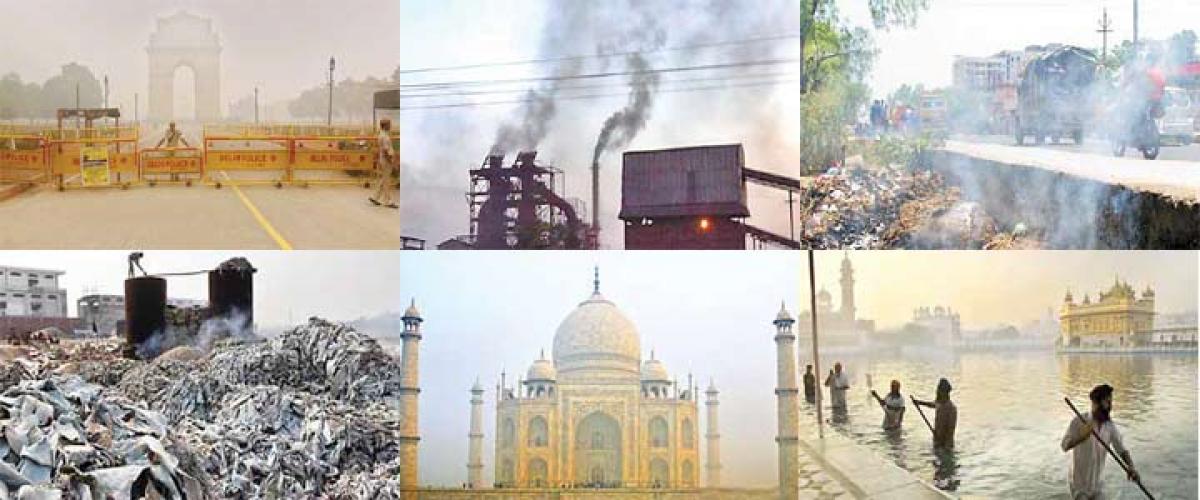Most polluted cities in India

The Tier 2 and Tier 3 cities are not equipped to deal with this sudden rise in pollution and have poor air quality monitoring systems. Hence, cities such as Agra, Raipur, Faridabad, Ludhiana and Patna report decreased air quality than metropolitan cities such as Delhi and Bengaluru.
Pollution levels in Indian cities have increased due to surge in construction work, boom in industrial activity and sharp spike in use of vehicles.
The Tier 2 and Tier 3 cities are not equipped to deal with this sudden rise in pollution and have poor air quality monitoring systems. Hence, cities such as Agra, Raipur, Faridabad, Ludhiana and Patna report decreased air quality than metropolitan cities such as Delhi and Bengaluru.
The report of high pollution levels of Indian cities comes at a time when the government has set an ambitious plan to build 100 smart cities across the country. Upto 17 of these proposed smart cities feature in the list of most polluted cities of the world.
While building smart cities, the government as well as the municipal bodies’ main focus should be on improving the air quality of these cities through proper regulations and administrative back up.
Here is a list of cities in India that feature on the list of the most polluted based on particulate matter (pm).
1.Delhi: The national capital’s situation is a matter of concern as the pollution is making millions of people vulnerable to physical ailments. According to the India Meteorological Department (IMD), visibility at Safdarjung and Palam was 400 and 500 metres respectively due to smog in the past few days.
As per the experts, unending burning of paddy stubble in Punjab, Harayana and Uttar Pradesh, low winds and pollution during Diwali and other sources of pollution along with weather-related factors led to such abnormal levels of smog.
Harmful particles less than 2.5 micrometers (PM2.5): 153g/m3
Harmful particles less than 10 micrometres (PM10): 286g/m3
2.Patna: Patna features in the second position as the most polluted city in India despite not being an industrial city.
The matter of concern here is the fact that Patna’s main source of income is agriculture which will surely suffer due to rise in the levels of pollution.
Harmful particles less than 2.5 micrometers (PM2.5): 149g/m3
Harmful particles less than 10 micrometres (PM10): 164g/m3
3.Gwalior: Gwalior, the city known for its architectural heritage, finds the third spot in the list. Tourism is the key source of income here but the pollution is going to affect not only the inflow of tourists but it is also going to take a toll on the historical monuments here.
Harmful particles less than 2.5 micrometers (PM2.5): 144g/m3
Harmful particles less than 10 micrometres (PM10): 329g/m3
4.Raipur: The capital of Chattishgarh, rich in coal, and with many power plants and industries in the region, produces maximum electricity in India. Unfortunately, these power plants and industries are also the reason behind the increase in pollution levels making it hazardous for the natives.
Harmful particles less than 2.5 micrometers (PM2.5): 134g/m3
Harmful particles less than 10 micrometres (PM10): 305g/m3
5.Ahmedabad: Ahmedabad is not only the fifth most polluted city in India but also ranks 27th in the world in the category. Ahmedabad, with its booming textile industry, is the third fastest growing city. However, the same textile industries have also resulted in the increase in pollution levels.
Harmful particles less than 2.5 micrometers (PM2.5): 100g/m3
Harmful particles less than 10 micrometres (PM10): 67g/m3
6.Firozabad: Firozabad, with a large concentration of glass industries, is renowned for the production of glass bangles. The glass industry has also contributed to the increased pollution levels. It now ranks sixth in India.
Harmful particles less than 2.5 micrometers (PM2.5): 96g/m3
Harmful particles less than 10 micrometres (PM10): 218.5g/m3
7.Amritsar: Increased vehicular traffic is the main reason behind the increased pollution in Amritsar. One of the largest cities in India, the increase in the purchasing ability of the natives has increased the number of vehicles in the city.
Harmful particles less than 2.5 micrometers (PM2.5): 92g/m3
Harmful particles less than 10 micrometres (PM10): 210g/m3
8.Kanpur: There are no laid guidelines and protocol for the control of pollution in Kanpur. Lack of awareness amongst the citizens has also contributed to northward trend of the pollution levels in Kanpur. The government needs to take immediate action to arrest this increase.
Harmful particles less than 2.5 micrometers (PM2.5): 88g/m3
Harmful particles less than 10 micrometres (PM10): 201.5g/m3
9.Agra: Home to one of the Seven Wonders of the World, the Taj Mahal, Agra is one of the most sought after tourist destinations. However, increase in pollution due to increased mining and dry sand is affecting the tourism industry in Agra. It’s also affecting one of the most magnificent monuments in the world.
Harmful particles less than 2.5 micrometers (PM2.5): 88g/m3
Harmful particles less than 10 micrometres (PM10): 200g/m3
10.Ludhiana: Ludhiana in Punjab has joined ranks with the most polluted cities of India. A hub of industries in India, the development has taken place without proper administrative checks which has led to the steady increase in the pollution levels. Ludhiana is now considered to be the 10th most polluted city of India.
Harmful particles less than 2.5 micrometers (PM2.5): 86g/m3
Harmful particles less than 10 micrometres (PM10): 195.5g/m3

